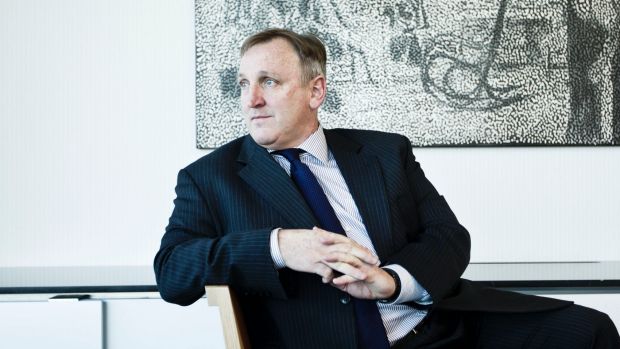Robert Cooke says Healthscope’s private hospital business could grow faster but is held back by full wards and operating theatres that are in action seven days a week, underlining the importance of the group’s target to open almost 1000 beds over the next three years.
The chief executive of the recently relisted $5 billion healthcare group said half-year hospital revenue growth of 6.3 per cent to $938.9 million was underpinned by patients with more complex and costly needs and new funding arrangements with private health insurers.
 Healthscope, led by chief executive Robert Cooke, said it is on track to meet full-year operating EBIT targets contained in its prospectus. Photo: Nic Walker
Healthscope, led by chief executive Robert Cooke, said it is on track to meet full-year operating EBIT targets contained in its prospectus. Photo: Nic Walker
However, the topline growth was restricted by capacity constraints – especially at large hospitals like Melbourne Private and Prince of Wales in Sydney – and the opening of only 23 new beds in the past 18 months.
Mr Cooke, delivering a return to the black with half-year net profit of $58.6 million, said the hospital group had looked to innovative solutions, like housing new mothers at nearby luxury hotels for care after childbirth. He said growth would only begin to increase beyond the current rate from the second half of 2015-16, when the first of 463 new beds opened.
“We have got more cranes than Shanghai at our hospitals at the moment,” he said of the $460 million development pipeline.
Hyperion Asset Management fund manager Joel Gray, who controls a Healthscope stake, said the firm expects revenue growth to increase to an average rate of 9 per cent over the next five years. “That is largely as a result of increasing the number of beds,” he said.
Mr Gray supported the pipeline of “brownfield” expansions, saying they are a less risky proposition than opening a new hospital and often “lead to good marginal profit and a higher return on capital”.
In addition to expansions at its existing hospitals, Healthscope will soon begin construction on the Northern Beaches Hospital – an $840 million public and private facility in Sydney that will have 488 beds and 14 operating theatres.
EBITDA targets in sights
Mr Cooke said Healthscope was on track to meet operating earnings before interest, tax, depreciation and amortisation targets contained in the prospectus. Healthscope shares rose 1.8 per cent to $2.85, hitting a new all-time high after listing in July 2014 with an offer price of $2.10.
Operating EBITDA in the 44-hospital division rose 11 per cent to $166.1 million.
Healthscope’s international pathology division, which operates in New Zealand, Singapore and Malaysia, had strong operating EBITDA growth of 17 per cent to $28.6 million. Mr Cooke said a number of small acquisition opportunities in Asia were being considered.
However the local pathology division struggled, with operating EBITDA falling 23 per cent to $9.3 million. Mr Cooke said the closure of Healthscope’s loss-making Queensland business, which was first revealed by Fairfax Media, meant that all remaining states were now profitable. However he said in NSW, where Healthscope is the third-placed player behind Primary Health Care and Sonic Healthcare, the operations still lacked scale “in terms of where pathology needs to be to get premium margins.”
We have got more cranes than Shanghai at our hospitals at the moment.
Robert Cooke, CEO, Healthscope
The Melbourne based company’s profit of $58.6 million is a turnaround from a loss of $27.8 million last year. On a pro-forma basis that removes costs associated with the float and a one-off tax effect, net profit was $82.7 million, which met expectations. Group revenue rose 6 per cent to $1.2 billion.
The board declared an interim dividend of 3.3¢ a share, to be paid on March 24.
